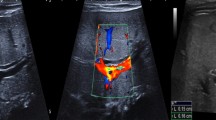Abstract
Thirty-three neonates and infants with cholestatic syndromes of various etiologies were evaluated by cholescintigraphy and ultrasound examinations. The results of these two diagnostic procedures were compared with the final diagnosis as confirmed by liver biopsy and/or laparotomy and the clinica follow-up of the infants. Fourteen patients had an obstructive cholangiopathy (11 biliary atresia, 2 choledochal cysts, 1 congenital choledochal stenosis), 13 had neonatal hepatitis, and 6 had cholestasis of another etiology. Typical ultrasonic and/or scintigraphic findings confirmed or excluded the need for surgical exploration in 28 patients. Thus, for must infants with cholestatic syndromes it is possible to differentiate the cause without invasive diagnostic techniques such as liver biopsy or exploratory laparotomy.
Similar content being viewed by others
References
Abramson SJ, Treves S, Teele RL (1982) The infant with possible biliary atresia: evaluation by ultrasound and nuclear medicine. Pediatr Radiol 12: 1–5
Alvares F, Yvart J, Odiévre M (1981) The rose bengal test in neonatal cholestasis: diagnostic and prognostic value. Eur J Pediatr 137: 27–29
Bläker F (1981) Differentialdiagnose des Ikterus. In: Bachmann KD, Ewerbeck H (ed) Pädiatrie in Praxis und Klinik. Thieme, Stuttgart, pp 133–135
Collier BD, Treves S, Davies MA, Heyman S, Subramian G, McAffe JG (1980) Simultaneous 99m-P-Tc-butyl-IDA and 131 J-rose-bengal scintigraphy in neonatal jaundice. Radiology 134: 719–722
Cooper PL, Burhenne HJ (1981) Real-time-ultrasonography: diagnostic technique of choice in calculous gallbladder disease. N Engl J Med 302: 1277–1279
Dewbury KC (1979) Visualization of normal biliary ducts with ultrasound. Br J Radiol 53: 774–780
Eißner D, Hahn K, Baumann W, Peters H (1982) Hepatobiliäre Sequenz- und Funktionsscintigraphie in der Pädiatrie. Nuklearmediziner 5: 27–38
Feist D (1979) Pathogenese der neonatalen Cholestase-Syndrome. Leber Magen Darm 9: 43–46
Fried AM, Bell RM, Bibins BA (1981) Biliary obstruction in a canine model: sequential study of the sonographic threshold. Invest Radiol 16: 317–319
Gates AF, Sinatra FR, Thomas DW (1980) Cholestatic syndromes in infancy and childhood. AJR: 1141–1148
Hayden PW, Rudd TG, Christie DL (1979) Rose bengal sodium 131 studies in infants with suspected biliary atresia. AM J Dis Child 133: 834–837
Laing FC, London FA, Filly RA (1978) Ultrasonic identification of dilated intrahepatic bile ducts and their differentiation from portal vein structures. JCU 6: 90–94
Lilly R (1955) The Japanese operation for biliary atresia: remedy of mischief? Pediatrics 55: 12–19
Manginello FP, Javitt NB (1979) Parenteral nutrition and neonatal cholestasis. J Pediatr 94: 295–298
Medrano-Heredia J, Schmidt G, Hartmann W, Heckemann R, Eigler FW (1979) Zur Diagnostik und Behandlung von Choledochuszysten. Leber Magen Darm 9: 85–93
Miller SH, Sinatra DW, Thomas DW (1980) Biliary excretion disorders in infants: evaluation using 99mTc PIPDA. AJR 135: 47–52
Owmann T, Reichardt W, Reichardt W (1979) Perkutane transhepatische Diagnostik und Therapie beim Stauungsikterus. Radiologie 19: 375–384
Parulekar S (1979) Ultrasound evaluation of common bile duct size. Radiology 133: 703–707
Perez-Soler A (1976) The inflammatory and the atresia inducing disease of the liver and the bile ducts. Monogr Pediatr 8: 20
Perlmutter GS, Goldberg BB (1976) Ultrasonic evaluation of the common bile duct. JCU 4: 107–111
Peters H, Dittrich M, Eißner D (1982) Ikterus. In: Weitzel D, Tröger J (eds) Morphologische Abdominaldiagnostik im Kindesalter. Springer, Berlin Heidelberg New York, pp 31–35
Peters H, Dittrich M, Dinkel E (1983) Sonograpische Diagnostik der Gallenwege im Kindesalter. Ultraschall Med 4: 147–153
Peters H, Baumann W, Dittrich M, Hofmann-v. Kap-herr S (1983) Association von Gallengangsatresien mit gastrointestinalen Fehlbildungen. In: Müller WD, Schober P (eds) Pädiatrische Intensivmedizin IV. Thieme, Stuttgart New York, pp 271–276
Peters H, Baumann W, Hahn K, Dittrich M, Rauber M, Loos L (1983) High resolution ultrasonography of the normal and the dilated biliary tract in neonates and young pigs: 28th Annual Convention of the American Institute of Ultrasound in Medicine, 18–21 Oct 1983, New York. J Ultrasound Med 2: 141
Piyachon CH, Poshychinda M, Dhitavat V (1976) Hepatoscintigraphy, arteriography and ultrasonography in preoperative diagnosis of choledochal cysts. AJR 127: 520–523
Poley JR (1979) Differentialdiagnose zwischen Gallengangsatresie und idiopathischer neonataler Hepatitis. Monatsschr Kinderheilkunde 127: 604–606
Rager R, Finegold MJ (1975) Cholestasis in immature newborn infants: is parenteral alimentation responsible? Pediatrics 86: 264–269
Rickham PP, Hirsig J (1979) Biliary atresia: recent advances in etiology, diagnosis and treatment. Z Kinderchir 26: 114–122
Sharp HL, Krivit Q, Lowmann JT (1967) The diagnosis of complete extrahepatic obstruction by rose bengal. J Pediatr 70: 46–53
Shawker TH, Jones BL, Girton ME (1981) Distal common bile duct obstruction: an experimental study in monkeys. JCU 9: 77–82
Thaler M, Gellis S (1968) Studies in neonatal hepatitis and biliary atresia. Am J Dis Child 116: 257–284
Touloukian RJ, Seashore JH (1975) Hepatic secretory obstruction with total parenteral nutrition in the infant. J Pediatr Surg 10: 353–360
Weitzel D, Beck JD (1974) Ultraschalltomographie: eine risikolose und schonende Methode zum Nachweis der angeborenen Choledochuszyste. Klin Pädiatr 186: 460–464
Yeung CY (1972) Serum 5′-nucleotidase in neonatal hepatitis and biliary atresia: preliminary observation. Pediatrics 50: 812–820
Zelter PM, Fonkalsrud RC, Nerhout RC, Stiehin ER (1974) Differentiation between neonatal hepatitis and biliary atresia by measuring serum alpha-fetoprotein. Lancet 1: 373
Author information
Authors and Affiliations
Rights and permissions
About this article
Cite this article
Peters, H., Eißner, D., Weitzel, D. et al. The diagnostic significance of cholescintigraphy and ultrasound examination in cholestatic syndromes in infancy. Pediatr Surg Int 3, 37–42 (1988). https://doi.org/10.1007/BF00177078
Accepted:
Issue Date:
DOI: https://doi.org/10.1007/BF00177078




